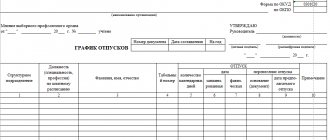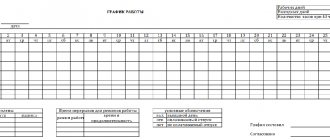You can organize the work schedule at an enterprise in different ways, choosing the most effective way of allocating time for work. If work must be in full swing, the usual working hours are not enough, and equipment can be used more efficiently with minimal interruptions, it makes sense to introduce a shift schedule.
- What are its specifics in accordance with the Labor Code,
- how workers’ work is organized at night,
- the correct procedure for drawing up and introducing such a schedule and familiarizing staff with it,
- as well as some restrictions that both the employer and employees working on a shift schedule should remember.
We consider all this below.
Reasons for introducing shift work
IMPORTANT! Recommendations for introducing shift work in an organization from ConsultantPlus are available here
Shift schedule is work organized in a special way, when working time is divided into two, three or four shifts, when each working group carries out its activities during one established working period of time according to an established schedule.
ATTENTION! It is prohibited for the same group of workers to work two shifts in a row.
Labor Code of the Russian Federation in Art. 103 provides for the possibility of organizing work on a shift schedule. The law specifies the features of this schedule and the circumstances that may serve as grounds for its introduction :
- the features of production require a continuous labor process;
- under normal operating conditions, the duration of the working day will exceed the permissible duration established by law;
- such a schedule will help increase the volume of products or services provided;
- thus, the efficiency of using equipment, machinery and tools increases.
IMPORTANT! The objectivity of these grounds allows the employer to introduce a shift schedule when he finds it appropriate.
What is a shift work schedule?
Important! Article 103 of the Labor Code of the Russian Federation states in black and white that a person cannot work two shifts in a row!
The same article of the Labor Code of the Russian Federation explains that a company can have a maximum of four shifts. Let us explain why shifts are needed in principle:
- To prevent employees from overworking.
- To ensure that the organization's equipment is used with maximum efficiency.
- To increase the output of goods.
When workers, or groups of workers, work in shifts, the firm can operate without stopping. But the schedule according to which people change must be approved in the form of a document. Moreover, the entire staff designated in this document must be familiarized with the schedule even before it comes into force. Moreover, in terms of time - at least 1 month.
Note: according to the labor code, the director of the company does not simply draw up a shift schedule and sign it. He is obliged to familiarize the workers with the document and ask their opinion (or the opinion of the trade union committee).
Which enterprises work on a shift schedule?
Provisions of Art. 103 clearly regulate the specifics of enterprises that can introduce a shift schedule: these are those organizations that must be constantly monitored by personnel. These include the following areas of work.
- Non-stop production. These are those plants and factories, the shutdown of which will cause problems in the national economy, or the shutdown of equipment can cause an emergency:
- chemical production;
- metallurgical enterprises;
- wood processing industry;
- automotive industry, etc.
- Emergency services. People need the availability of certain services around the clock, and the activity must occur immediately. The following services should be available at any time:
- medical;
- fire department;
- gas;
- law enforcement (police);
- Ministry of Emergency Situations.
- Services that provide infrastructure. Cargo and passengers move around the clock, so the transport sector must work without interruption:
- rail transportation;
- automobile companies;
- water transport;
- air travel;
- pipeline.
- Trade and service sector. For the owners of such enterprises, continuous work to provide their services is more effective:
- convenience stores;
- hotels;
- restaurants;
- some service departments, etc.
Also, those enterprises where such use of equipment, premises and territory will be considered more effective have the right to introduce such a schedule.
Division into shifts
To work on a shift schedule, all personnel are divided into work groups (teams, shifts), each of which will work during one time period allocated to them. They perform their work sequentially; the purpose of such an organization is to eliminate pauses in the production process.
The Labor Code of the Russian Federation does not give clear recommendations on the division of workers into shifts. There is no minimum limit for group composition. Therefore, by default, based on the definition of “group of employees” used in the legislation, it follows that in order to introduce a shift schedule, the staff must have at least three employees, since it is impossible to work two shifts in a row (two work in different shifts, and the third is on vacation).
The number of shifts is also not limited by law. In practice, enterprises most often choose a two- or three-shift option, less often a four-shift option. An employer can divide a day into any number of shifts, depending on the number of its personnel and the nature of the work.
Schedule according to shift schedule
The employer develops and approves this document in addition to current regulations. It should take into account the following nuances:
- the number of shifts into which working time is divided;
- start and end times of each shift;
- lunch breaks and shift changes (if any);
- the order in which the shifts alternate;
- rest regime between shifts;
- shift composition and transfer possibilities for workers;
- procedure in case of emergency situations (for example, no-show of a shift worker).
The form for drawing up such a schedule can be arbitrary, but most employers use a unified work time sheet, where in columns 1-6 they note the features of the shift schedule.
is approved as an additional agreement to the collective agreement. But if the organization has not concluded a collective labor agreement, then the schedule can be issued as a separate regulatory act or act as an annex to the internal regulations.
Coordination of the drawn up schedule is mandatory (this is required by Article 371 of the Labor Code of the Russian Federation):
- with a trade union organization, if it operates at the enterprise;
- with any employee representative body (for example, a general meeting).
Time of preparation: it is not necessary to approve the schedule for the entire working period at once; any time period is acceptable: a month, a quarter, or any stage of the accounting period. It is not necessary to have a single constant schedule; corrections and changes are allowed.
Employees must be familiarized with the schedule no less than 30 days before its introduction (Part 4 of Article 103 of the Labor Code of the Russian Federation). This must be documented in writing, that is, confirmed by the employee’s handwritten, dated signature on the appropriate document.
Sample shift work schedule
Enter the shift schedule
Preparation of the future shift work schedule is carried out in several stages. They will precede the schedule coming into effect.
- The first stage is to prepare a draft order, which reflects the specific start date of the shift schedule according to operating modes.
- The second stage is getting to know the employees’ schedule. It is necessary not only to show everyone the finished version, but also to obtain a signature from each employee involved in the schedule. Typically, this procedure is performed two months before the document on changing the schedule comes into force. This rule is regulated by Article 74 of the Labor Code of the Russian Federation.
- The third stage - you need to secure data about shifts and employees approved for them in a local act. This can be PVTR (internal labor regulations), or a collective agreement (collective labor agreement). This is a mandatory step!
- The fourth stage - the finished draft schedule, along with the order, must be sent to a representative of the labor collective, or to the trade union committee.
- The fifth stage is approval. This is done using an order, a sample of which can be easily downloaded on the Internet if this is your first time encountering this.
- The last stage is notification. We inform those involved in the changes to the new schedule that in one month the conditions will come into force (regulated by Article 103 of the Labor Code).
Important! After receiving consent to the established schedule, each employee will need to enter into an additional agreement to the employment contract stating that the working conditions will change.
If the employee disagrees, you need to offer him other employment. However, if there are no vacancies, you have the right to dismiss the worker in accordance with the seventh paragraph of the first part of Article 77 of the Labor Code.
Night shifts
With a shift organization of the work process, some amount of working time may fall at night. According to the law, night time is considered to be the time starting from 22 o'clock to 6 o'clock in the morning. If half of the time or more in a shift falls within this period, it is classified as a night shift (Article 96 of the Labor Code of the Russian Federation).
The night shift must be 1 hour shorter than the usual day shift, and such a reduction does not include any compensatory work.
The law provides for some categories that cannot be used at work “at night,” even with their consent:
- pregnant women;
- workers under 18 years of age (exception - if they are authors or performers of artistic works);
- persons considered such in industry documents or local regulations.
If written consent has been previously received (but only in this case!) the following may be assigned to the night shift:
- mothers of children under three years of age;
- disabled people of any group;
- persons caring for disabled people or sick relatives (with medical documentary evidence);
- Single parents whose children are under 5 years old.
Work on holidays
If the work shift falls on a day that is a public holiday, then the employee is given the choice:
- receive double pay for work that day;
- additional rest on another day agreed with the employer (with regular pay).
If an employee works in shift mode, then his vacation begins and ends on the calendar dates determined by the vacation schedule. What are the features of providing annual leave to an employee with a shift work schedule ?
Rights and responsibilities of those using a shift schedule
Both parties working on a shift schedule must strictly comply with the requirements prescribed by law regarding this specific form of work organization.
- The total working hours cannot be higher than those provided for by the limits for the selected accounting period.
- Each shift cannot last longer than established by the Labor Code (Article 94).
- According to the norms (Article 110 of the Labor Code of the Russian Federation), during a week in shifts, an employee cannot be employed for less than 42 hours.
- An incorrectly drawn up or inconsistent shift schedule is a reason for challenging it in court.
How is work paid on a shift schedule ?
Features of the “in three days” schedule
With the “every three days” schedule, it is advisable to define an accounting period equal to a year. An accounting period of shorter duration (for example, a quarter or a month) will not allow for compliance with the standard working hours without employees working overtime. It is worth noting that work that is overtime must be compensated additionally: for the first couple of hours of work no less than one and a half times the amount, for the next hours no less than double the amount. In addition, overtime work can be compensated not only with money, but also with the provision of additional rest.
Why is it advisable to establish an annual accounting period when working “in three days” in 2021? With an accounting period that is equal to a year, overtime in one month can be compensated for by shortfalls in another during the year, and, if necessary, additional days off can be distributed as evenly as possible. Although there is another option for complying with labor laws: drawing up a work schedule for a month without overtime and providing the employee with an additional day off.
When implementing flexible working hours, you are required to keep accurate records of the hours your employee actually works. Working hours are recorded in the form approved in the company’s accounting policies for accounting purposes. To record the time worked by an employee in the “every three days” mode, a time sheet form is used. You can keep timesheets using standardized forms, or develop a form yourself.
Each employee must know in advance what his work schedule will be. The employer must draw up a “every three days” shift schedule in advance, approve and put it into effect. Employees must review the work schedule and sign it.
Correction of shift schedule
During the operation of an enterprise, situations may arise when an already drawn up and agreed upon shift schedule has to be changed. How, then, can this be formalized and put into practice?
First of all, you need to inquire about the employees’ consent to perform their duties on a different schedule. If they do not mind, you need to immediately get their signature to familiarize yourself with the new dates of return to work. In these cases, the mandatory monthly interval for reporting is not required (Article 72 of the Labor Code of the Russian Federation).
If the need for correction is identified in advance, changes can be made to the schedule without the consent of the employees, in accordance with Art. 74 Labor Code of the Russian Federation. In order to thoroughly change the data in the schedule, you need to give people the opportunity to receive information about the adjustment 60 days before it is entered, and familiarize themselves with the specific provisions for signature, as required, at least a month in advance.
If employees do not agree to accept the changes, then they can be dismissed on this basis (clause 7, part 1, article 77 of the Labor Code of the Russian Federation). Challenging such a dismissal in court will be doomed for the employee if the employer proves that he made changes as part of organizational measures. In this case, you need to act according to the following algorithm:
- issue an order to adjust the schedule, which provides the reasons for the changes (for example, the requirements of a new production process);
- inform employees 2 months in advance;
- give employees a month to familiarize themselves with the new provisions of the schedule;
- conclude an additional agreement with them to the employment contract (or fire those who disagree).
How to correctly create a shift schedule
During shift work, employees work during the established working hours in accordance with the shift schedule. When compiling it, it is necessary to take into account the opinion of the trade union or other representative body of employees, if there is one, of course (Parts 2 and 3 of Article 103 of the Labor Code of the Russian Federation).
When drawing up shift schedules, it is necessary to take into account the following features of shift work:
- the duration of working hours should not exceed the established norm (Part 2 of Article 91 of the Labor Code of the Russian Federation). At the same time, if an organization (institution) has introduced summarized recording of working hours, when determining the normal number of working hours, it is necessary to take into account the features established by Article 104 of the Labor Code of the Russian Federation;
- for certain categories of employees, the duration of the work shift should not exceed the established limit (Article 94 of the Labor Code of the Russian Federation);
- the work shift immediately preceding a non-working holiday is reduced by one hour (Part 1 of Article 95 of the Labor Code of the Russian Federation);
- the night shift is reduced by one hour without further work (part 2 of article 96 of the Labor Code of the Russian Federation);
- work for two shifts in a row is prohibited (Part 5 of Article 103 of the Labor Code of the Russian Federation);
- weekly continuous rest should not be less than 42 hours (Article 110 of the Labor Code of the Russian Federation).
There is no standard form for the shift schedule. Therefore, you have the right to draw up a document in any form. The shift schedule can be drawn up as an appendix to a local regulatory act establishing the shift nature of work (collective agreement, labor regulations, etc.), or approved as a separate document by order of the head of the company.
For convenience, you can use the unified form provided for the time sheet (form No. T-13). For this purpose, columns 1–6 can be used in this form.
The employer must communicate the approved shift schedule to each employee no later than one month before it comes into effect (Part 4 of Article 103 of the Labor Code of the Russian Federation).
The shift schedule is a mandatory document for the parties to the employment contract, therefore the organization (institution) does not have the right to hire an employee to work outside the schedule, with the exception of some cases of involvement in overtime work (Articles 99, 103 of the Labor Code of the Russian Federation).
Please pay special attention: draw up the shift schedule so that the employee’s working hours do not exceed the normal number of hours for this category of persons during the accounting period. Therefore, overtime work cannot be included in the shift schedule. Determine the hours worked overtime by the employee on the basis of the time sheet (in particular, according to form No. T-12 - for commercial organizations, according to form No. 0504421 - for state (municipal) institutions). It should be taken into account that overtime work should not exceed four hours for each employee for two days in a row and 120 hours per year (Part 1, 6 of Article 99 of the Labor Code of the Russian Federation).
How long can a shift last?
As a rule, shift work is introduced together with the summarized recording of working hours. It applies if the duration of work of employees deviates from the established norm of 40 hours per week (Part 1 of Article 104 of the Labor Code of the Russian Federation).
The maximum duration of a work shift is not established by law (letter of Rostrud dated December 2, 2009 No. 3567-6-1). An exception to this rule are certain categories of employees for whom working time during a shift is limited. These include, in particular:
- minors;
- disabled people (the duration of the work shift is established in accordance with a medical report);
- car drivers (part 2 of article 329 of the Labor Code of the Russian Federation, section 2 of the Regulations approved by order of the Ministry of Transport of Russia dated August 20, 2004 No. 15).
A detailed list of employees who have a maximum work shift duration is given in Article 94 of the Labor Code of the Russian Federation.







